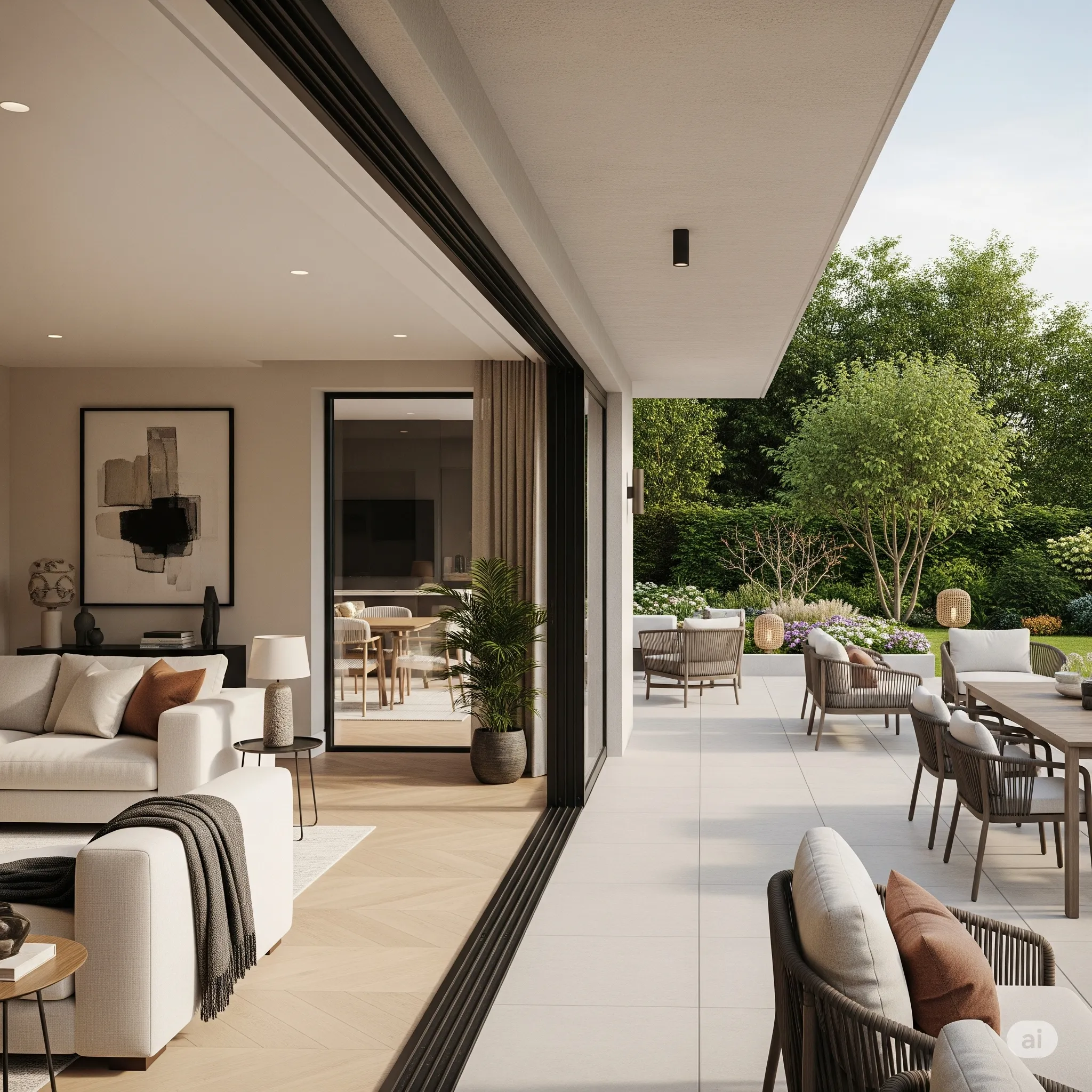In the modern home, the rigid distinction between indoor and outdoor living is increasingly fading. Driven by a desire for more light, more space, and a deeper connection to nature, contemporary design embraces the concept of seamless transitions, blurring the boundaries between interior comfort and exterior beauty. This isn’t just a trend; it’s a strategic approach to design that expands your perceived living area, enhances well-being, and creates a harmonious flow that invites the outdoors in, and extends your indoor experience out.
Imagine a home where the living room effortlessly spills onto a patio, where a kitchen connects directly to an edible garden, or where a bathroom feels like an open-air spa. This fluidity creates a sense of liberation, making spaces feel larger, brighter, and more connected to the surrounding environment. It’s about maximizing every square foot, not just within walls, but by integrating the untouched beauty of nature.
The Philosophy of Blurring Boundaries
The core idea behind seamless indoor-outdoor design is to minimize visual and physical barriers between the interior and exterior. This philosophy extends beyond mere functionality, aiming to create a continuous sensory experience that benefits from both environments. It’s about leveraging natural light, fresh air, and the calming influence of greenery to enhance daily life.
This approach acknowledges our inherent desire for nature (biophilia) and seeks to incorporate it into our everyday living, fostering a sense of peace, creativity, and connection.
Architectural Elements: The Foundation of Fluidity
The most impactful seamless transitions often begin with smart architectural choices:
- Large Sliding or Folding Glass Doors: These are perhaps the quintessential element. When fully opened, they create expansive, unobstructed pathways, literally removing walls and inviting the outdoors in. Look for systems that allow panels to stack neatly to one side.
- Floor-to-Ceiling Windows: Even without opening, these windows offer panoramic views, flooding interiors with natural light and visually connecting the inside to the outside landscape.
- Continuous Flooring Materials: Extending the same flooring material (e.g., large format tiles, concrete, or specific types of wood) from the interior to the exterior patio or deck immediately creates a sense of continuity and makes the space feel larger.
- Covered Outdoor Living Areas: Overhangs, pergolas, or retractable awnings provide shade and shelter for outdoor spaces, making them usable in various weather conditions and extending the functional living area.
Design Strategies: Weaving the Inside and Out
Beyond the architecture, intentional design choices are crucial for a truly seamless transition:
- Mirrored Furniture Styles: Choose outdoor furniture that echoes the style, material, or color palette of your indoor pieces. This visual consistency helps to blur the line between the two zones. For instance, if you have a minimalist indoor sofa, select outdoor lounge chairs with similar clean lines.
- Consistent Color Palettes: Maintain a cohesive color scheme that flows from inside to out. Using similar neutrals, earth tones, or accent colors in both spaces creates a unified look.
- Strategic Plant Placement: Bring potted plants indoors that mimic the types of plants found just outside. Conversely, extend indoor plant choices to your patio. This creates a visual bridge and reinforces the natural connection.
- Outdoor “Rooms” with Purpose: Define outdoor areas with the same intentionality as indoor rooms. Create an outdoor dining area, a lounge zone, or even an outdoor kitchen, making them distinct functional spaces.
- Indoor-Outdoor Textiles: Use cushions, throws, and rugs specifically designed for outdoor use but with patterns and textures that complement your indoor decor. This adds comfort and visual warmth to the exterior.
- Integrated Lighting: Plan your indoor and outdoor lighting together. Use similar fixtures or lighting temperatures to ensure a smooth transition of ambiance from day to night. Accent lighting in the garden can become a beautiful focal point when viewed from indoors.
Art and Decor: Echoing the Landscape
Art plays a subtle yet powerful role in enhancing seamless transitions:
- Nature-Inspired Art: Paintings, sculptures, or photography depicting landscapes, botanicals, or natural elements can visually extend the outdoor beauty into your interior, especially when actual views are limited.
- Organic Materials in Art: Choose art pieces crafted from natural materials like reclaimed wood, stone, woven fibers, or metals that develop a natural patina. These materials resonate with the outdoor environment.
- Sculptural Elements in the Garden: Place outdoor sculptures or visually interesting planters that serve as art pieces, creating focal points that can be appreciated from both inside and out.
- Water Features: A small water feature visible or audible from indoors can bring the calming sounds and reflections of nature into your home, serving as a living art installation.
The Benefits: More Than Just Aesthetics
The thoughtful integration of indoor and outdoor spaces yields a multitude of benefits:
- Expanded Living Area: Your home feels significantly larger and more luxurious.
- Enhanced Natural Light: Interiors become brighter, reducing the need for artificial lighting during the day.
- Improved Air Quality: Increased airflow and connection to outdoor greenery contribute to a healthier indoor environment.
- Boosted Well-being: Access to nature has proven psychological benefits, reducing stress and enhancing mood.
- Increased Property Value: Homes with well-executed indoor-outdoor flow are highly desirable.
- Versatile Entertainment Spaces: Hosting gatherings becomes effortless, with options to enjoy both indoor comfort and outdoor charm.
Final Thoughts: Living Limitlessly
Mastering the art of seamless transitions is about designing a home that lives larger than its footprint, a space where the boundaries between inside and out gracefully dissolve. It’s about creating an environment that feels expansive, connected, and deeply harmonious with the natural world around it. By strategically employing architectural elements, thoughtful design choices, and nature-inspired art, you can transform your home into a sanctuary that celebrates fluidity, maximizes light and space, and invites a limitless way of living. Embrace the open door, the clear view, and the continuous flow, and discover the true bliss of a home that embraces the beauty of every boundary blurred.
